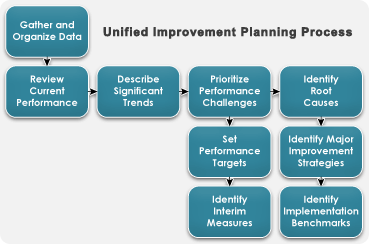District and School Accountability Committees have a legal existence that is separate and apart from school districts and boards of education. Fundamentally, they were created by the Colorado Legislature to ensure independent parent and business community review of student achievement results versus goals, the root causes of any underperformance, and the plans and budgets that are proposed to drive improvement. By law, DACs advise local boards of education on these issues. SACs provide advice to both the school principal and to the DAC. In addition, parents must represent a plurality of accountability committee membership.
Each year, every school and district in Colorado prepares a Unified Improvement Plan. These “UIPs” are intended to drive a continuous student achievement improvement process. Each UIP has three main sections: (1) a discussion of the previous year’s results and identification of key achievement problems; (2) discussion of the root causes of these problems; and (3) a detailed description of the major improvement initiatives that will be undertaken over the next 12 months to address the identified root causes, as well as clear metrics and goals that will be used to evaluate these initiatives. DACs and SACs provide advice as to the contents of these UIPs, which ultimately must be approved by the local board of education before being submitted to the Colorado Department of Education.
The good news is that there is an increasing amount of research evidence to guide the formulation of achievement improvement programs. For example, see this excellent paper from the Brookings Institution that describes an integrated program to improve K12 achievement that is solidly based on high quality research. Or take a look at this excellent site in the UK that systematically evaluates the cost and effectiveness of a wide range of achievement improvement ideas.

While not an explicit duty in law, another logical (and critical) function performed by DACs and SACs is to assess the implementation and results of the major improvement initiatives contained in previous years’ UIPs. This critical feedback loop should precede work on the current year’s UIP.
The major improvement initiatives are also a critical link between the UIP and DAC’s and SACs’ advisory duty with respect to district and school budgets; if these initiatives are not adequately funded, they will almost certainly fail.
However, DACs’ and SACs’ budgeting duties go beyond this, and raise more difficult issues. In broad terms, different approaches to budgeting and budget analysis can be categorized using a 2x2 matrix. The key question on the first dimension is whether you are looking at just incremental spending proposals or at the entire budget.
The key question on the second dimension is whether you are using an old-fashioned “line item”/accounting chart of accounts approach to budget analysis and decision making, or an activity based approach that clearly links achievement improvement goals to changes in activities that are required to reach them, and in turn to these activities’ staffing, investment (facilities, ITC, etc.), and budget implications (which in turn can be rolled up into the traditional accounting chart of accounts).
Most private sector companies annually look at their total, not incremental, budget, using some variation of an activity-based approach. The reason for looking at the total budget is obvious — at most companies, pressures on profits are continually intensifying, resources are always scarce, and the business environment is rapidly evolving, all of which necessitate the constant adjustment of strategy and plans, and reallocation of resources to support their implementation. To only look at the allocation of incremental resources in the budgeting process creates an enormous bias in favor of the status quo, which in fast evolving environments can (and usually does) lead to organizational failure.
The reason for using the activity-based approach is that the traditional accounting “line item” methodology creates a disconnect between resource allocation and the achievement of critical goals — private sector boards eventually tired of this “black box” approach, and demanded that management teams provide a more transparent linkage — or logic model, if you will — between goals (e.g., meeting the five key student achievement improvement goals established by the board), changes in activities, changes in staffing and investments, and changes in budgets. If you doubt the need for this in K-12, just ask your superintendent how much (in direct costs and the value of employees’ time) the district spends on professional development, how they measure its effectiveness, and what return they are getting on this investment. Then ask the same questions about the selection and evaluation of curriculum and instructional materials.
Unfortunately, too many DACs and SACs still focus only on incremental spending, using a traditional accounting line item approach that is made even more confusing by the public sector’s use of fund accounting. At a time when the bar for “college and career readiness” is rapidly rising (even though our kids still have only 13 years to reach it), and educational innovations are exploding, creating a strong bias in favor of the status quo is exactly the wrong approach to take.
More broadly, it is hard to see how Colorado taxpayers will support increases in funding for K12 public schools if districts fail to make explicit the activities on which existing funds are being spent, and the linkages of these activities to student achievement results, and why they believe more funding is needed to drive faster performance improvement. For example, this private sector review of Boston Public Schools’ cost structure highlighted many opportunities for freeing up funds in the existing budget that could be spent on achievement improvement initiatives.
In sum, the work of District and School Accountability Committees is central to meeting the challenge of improving student achievement results in Colorado. One of the reasons we started K12 Accountability was to provide DAC and SAC members with the evidence and analysis they need to perform their roles exceptionally well.